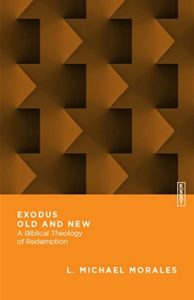 The book of Exodus is full of vivid supernatural occurrences from the burning bush in chapter three to the presence of the cloud and fire above the tabernacle testifying to the Lord’s presence as the book concludes. It provides the record of the baby named Moses removed from a basket in the bullrushes to be raised up by God as leader of the exodus of Hebrews from bondage in Egypt to within sight of the promised land. Some key aspects of Exodus are sin, salvation, and the Law; God’s faithfulness to fulfill his covenant promises to the patriarchs through the exodus; and as Professor of Biblical Studies L. Michael Morales of Greenville Presbyterian Theological Seminary points out, it is also a historical-theological event bearing the motif of exodus and redemption which he explains in Exodus Old and New: A Biblical Theology of Redemption, IVP Academic, 2020.
The book of Exodus is full of vivid supernatural occurrences from the burning bush in chapter three to the presence of the cloud and fire above the tabernacle testifying to the Lord’s presence as the book concludes. It provides the record of the baby named Moses removed from a basket in the bullrushes to be raised up by God as leader of the exodus of Hebrews from bondage in Egypt to within sight of the promised land. Some key aspects of Exodus are sin, salvation, and the Law; God’s faithfulness to fulfill his covenant promises to the patriarchs through the exodus; and as Professor of Biblical Studies L. Michael Morales of Greenville Presbyterian Theological Seminary points out, it is also a historical-theological event bearing the motif of exodus and redemption which he explains in Exodus Old and New: A Biblical Theology of Redemption, IVP Academic, 2020.
After opening his preface with a quote from Dante’s Inferno, Dr. Morales sets forth his plan to cover the three major exodus movements in Scripture. The first is the exodus out of Egypt; the second is the prophesied second exodus; and the last is “the new exodus accomplished by Jesus Christ” (xii). Then, the text is divided into three sections corresponding with the exodus movements mentioned in the preface. The author presents his case with a considerable number of Bible passages exemplified by the lengthy Scripture index including references from 47 of the 66 books with the Pentateuch predominating. Inclusion of a full bibliography would have been helpful because it would provide readers with publications the author read but did not use to make his case. Instead of a bibliography a catalog of publications suggested for further reading is given along with a list of authors mentioned in the text with the page numbers upon which their names occur. For clarification some diagrams illustrating complex points are scattered throughout the book.
When events related to the exodus are remembered one of central significance is the Passover, but Dr. Morales sees it having crowning importance, “one cannot grasp the meaning of Israel’s exodus out of Egypt without understanding the Passover ritual—the Passover is the exodus” (66). The first Passover ritual anticipated God passing over the Jewish households as the tenth plague (the author uses sign instead of plague) was brought upon Egypt taking the lives of the first born and it set the pattern for its rehearsal the first month of each succeeding year in the future. Morales emphasizes that the tenth sign required the Hebrews to obey the Lord’s command to take blood from the Passover lamb and apply it to their door posts and lintels. The blood showed the house was inhabited by Jews. God the omniscient ruler of all the nations did not need blood-marked doors to distinguish the houses to pass over, but Yahweh (the author’s preferred name) the covenantal ruler of his children required them to obey if benefit from the passing over was to be received. Thus, the author turns the tables in a good sense because the tendency for Christians as celebrants of the Lord’s Supper is to diminish the Passover and ceremonies of the Jews because they have been fulfilled in Christ. Fulfillment does not imply that the meaning and historical significance of the ceremonies are irrelevant for Christians. Jews had Passover and circumcision; Christians have the Lords Supper and baptism. The author uses several works by Jewish scholars in Exodus Old and New and Christians may want to adopt a similar expanded field of reading to answer pre-incarnation questions which Jewish observations may resolve. The exodus led by Moses would be redemption for the people of God and it ultimately looked to the exodus of Christ manifest in resurrection and redemption.
There are several other selections from Exodus Old and New which could be noted in this review but reviews should not get too long. Some other passages found particularly beneficial are “Hope for a Second Exodus out of Exile,” 113-18, and chapter 10, “The Servant of the Second Exodus,” 134-47. However, one portion is particularly appropriate for today. The last chapter, “The Only Hope,” includes the following observation.
History is an open book: daily tragedies of violence and depravity scorn the pleas of enlightenment—to say nothing of the chronic ideologies that justify and spur such brutality. Even so, within the unrelenting sorrows and shallow revelries of human civilization, the fear of death continues to hold sway over every living soul. How plainly, from within the house of mourning and before the cold stare of the gravestone or amidst the turmoil of nations and the violence in our streets, we see that apart from the resurrection of the dead all our hopes and human endeavors are vain, and resolutely so. (186)
Exodus for the Jews was their only hope for relief from Pharoah’s oppression as they anticipated the coming Messiah, and the exodus of resurrection with Christ is the only hope for all. Exodus Old and New encourages readers to remember that through faith in Christ who fulfilled the Passover promise of the exodus, lives are changed through the exodus of redemption accomplished by the resurrected and ascended Christ. The book concludes with the following quotation from the Book of Common Prayer.
O God, who by the glorious resurrection of your Son Jesus Christ destroyed death and brought life and immortality to light: Grant that we, who have been raised with him, may abide in his presence and rejoice in the hope of eternal glory; through Jesus Christ our Lord, to whom, with You and the Holy Spirit, be dominion and praise for ever and ever. Amen.
Barry Waugh
Notes—The copy of the book used for this review was provided by Greenville Presbyterian Theological Seminary. The page of Bible text in the header is from a copy of the first edition of the King James Version, 1611, as available on Internet Archive.





